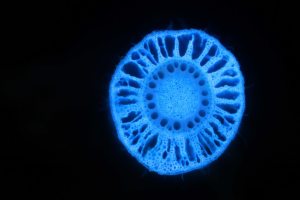Life Sciences
Gene Discovery May Help Effort to Breed Climate Resilient Crops
The gene controls formation of air spaces among living root tissues. Replacing a large percentage of root cells with airspaces saves the plant much energy…

Researchers say they have learned how a key gene in plants allows them to use their energy more efficiently, enabling them to grow more roots and capture more water and nutrients. An international team of plant scientists led by Penn State University and in collaboration with the University of Nottingham have discovered this novel regulatory gene (called bHLH121) that enables corn roots to acquire more water and nutrients.
The findings “Transcription factor bHLH121 regulates root cortical aerenchyma formation in maize have been published” appear in PNAS.
“Root anatomical phenotypes present a promising yet underexploited avenue to deliver major improvements in yield and climate resilience of crops by improving water and nutrient uptake. For instance, the formation of root cortical aerenchyma (RCA) significantly increases soil exploration and resource capture by reducing the metabolic costs of root tissue. A key bottleneck in studying such phenotypes has been the lack of robust high-throughput anatomical phenotyping platforms,” write the investigators.

“We exploited a phenotyping approach based on laser ablation tomography, termed Anatomics, to quantify variation in RCA formation of 436 diverse maize lines in the field. Results revealed a significant and heritable variation for RCA formation. Genome-wide association studies identified a single-nucleotide polymorphism mapping to a root cortex-expressed gene-encoding transcription factor bHLH121.
“Functional studies identified that the bHLH121 Mu transposon mutant line and CRISPR/Cas9 loss-of-function mutant line showed reduced RCA formation, whereas an overexpression line exhibited significantly greater RCA formation when compared to the wild-type line. Characterization of these lines under suboptimal water and nitrogen availability in multiple soil environments revealed that bHLH121 is required for RCA formation developmentally as well as under studied abiotic stress.
“Overall functional validation of the bHLH121 gene’s importance in RCA formation provides a functional marker to select varieties with improved soil exploration and thus yield under suboptimal conditions.”
The gene controls the formation of air spaces among living root tissues (root cortical aerenchyma). Replacing a large percentage of root cells with airspaces saves the plant a lot of energy which is otherwise required to feed all these root cells. This makes roots metabolically more efficient, enabling them to use the resources saved to build more roots and explore the soil more effectively and capture more water and nutrients.
This discovery could lead to the breeding of crops that can withstand drought and low-nitrogen soil conditions and ultimately ease global food insecurity, the researchers suggest.
“Identifying this gene and how it works will enable us to create more resilient crops that can withstand water and nutrient stress conditions being experienced as a result of climate change,” says Rahul Bhosale, assistant professor in crop functional genomics from the School of Biosciences at the University of Nottingham and BBSRC Discovery Fellow.”
The research team used imaging tools developed in previous research at Penn State that rapidly measured cells in thousands of roots. One technique, Laser Ablation Tomography, was critical for this approach which is also now available at the University of Nottingham through BBSRC Alert Funding and support from U.S. partners.
The post Gene Discovery May Help Effort to Breed Climate Resilient Crops appeared first on GEN – Genetic Engineering and Biotechnology News.

Wittiest stocks:: Avalo Therapeutics Inc (NASDAQ:AVTX 0.00%), Nokia Corp ADR (NYSE:NOK 0.90%)
There are two main reasons why moving averages are useful in forex trading: moving averages help traders define trend recognize changes in trend. Now well…
Spellbinding stocks: LumiraDx Limited (NASDAQ:LMDX 4.62%), Transocean Ltd (NYSE:RIG -2.67%)
There are two main reasons why moving averages are useful in forex trading: moving averages help traders define trend recognize changes in trend. Now well…
Asian Fund for Cancer Research announces Degron Therapeutics as the 2023 BRACE Award Venture Competition Winner
The Asian Fund for Cancer Research (AFCR) is pleased to announce that Degron Therapeutics was selected as the winner of the 2023 BRACE Award Venture Competition….














